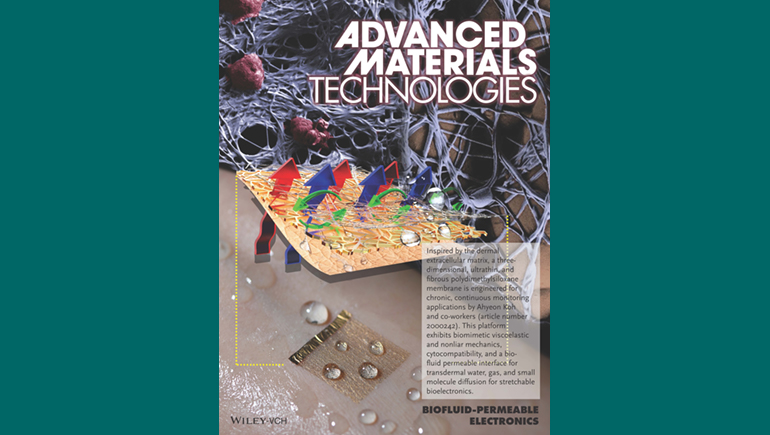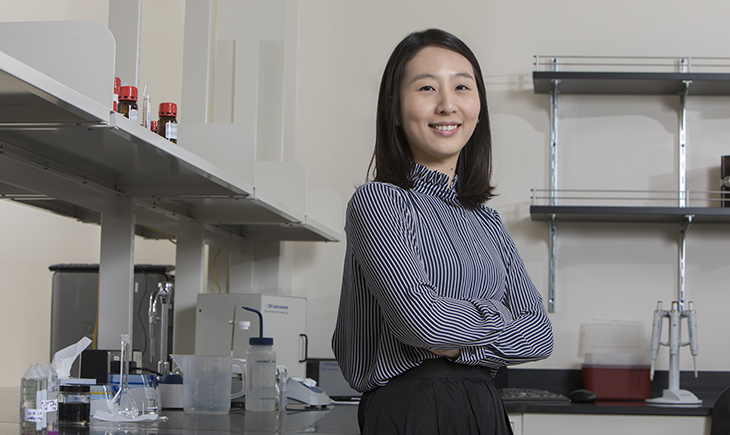Watson researchers create better material for wearable biosensors
Professors, PhD students use electrospinning to make porous silicone that allows sweat to evaporate

Biosensors that are wearable on human skin or safely used inside the body are increasingly prevalent for both medical applications and everyday health monitoring.
Finding the right materials to bind the sensors together and adhere them to surfaces is also an important part of making this technology better.
A recent study from Binghamton University’s Thomas J. Watson College of Engineering and Applied Science offers one possible solution, especially for skin applications.
Matthew S. Brown, a fourth-year PhD student with Assistant Professor Ahyeon Koh’s lab in the Department of Biomedical Engineering, served as the lead author for “Electronic‐ECM: A Permeable Microporous Elastomer for an Advanced Bio‐Integrated Continuous Sensing Platform,” published in the journal Advanced Materials Technology.
The study utilizes polydimethylsiloxane (PDMS), a silicone material popular for use in biosensors because of its biocompatibility and soft mechanics. It’s generally utilized as a solid film, nonporous material, which can lead to problems in sensor breathability and sweat evaporation.
“In athletic monitoring, if you have a device on your skin, sweat can build up under that device,” Brown said. “That can cause inflammation and also inaccuracies in continuous monitoring applications.”
For instance, one experiment with electrocardiogram (ECG) analysis showed that the porous PDMS allowed for the evaporation of sweat during exercise, capable of maintaining a high-resolution signal. The nonporous PDMS did not provide the ability for the sweat to readily evaporate, leading to a lower signal resolution after exercise.
The Watson team created a porous PDMS material through electrospinning, a production method that makes nanofibers through the use of electric force.
During mechanical testing, the researchers found that this new material acted like the collagen and elastic fibers of the human epidermis. The material was also capable of acting as a dry adhesive for the electronics to strongly laminate on the skin, for adhesive-free monitoring. Biocompatibility and viability testing also showed better results after seven days of use, compared to the nonporous PDMS film.
“You can use this in a wide variety of applications where you need fluids to passively transfer through the material — such as sweat — to readily evaporate through the device,” Brown said.
Because the material’s permeable structure is capable of biofluid, small-molecule and gas diffusion, it can be integrated with soft biological tissue such as skin, neural and cardiac tissue with reduced inflammation at the application site.
Among the applications that Brown sees are electronics for healing long-term, chronic wounds; breathable electronics for oxygen and carbon dioxide respiratory monitoring; devices that integrate human cells within implantable electronic devices; and real-time, in-vitro chemical and biological monitoring.
Koh — whose recent projects include sweat-assisted battery power and biomonitoring — described the porous PDMS study as “a cornerstone of my research.”
“My lab is very interested in developing a biointegrated sensing system beyond wearable electronics,” she said. “At the moment, technologies have advanced to develop durable and flexible devices over the past 10 years. But we always want to go even further, to create sensors that can be used in more nonvisible systems that aren’t just on the skin.”
Koh also sees the possibilities for this porous PDMS material in another line of research she is pursuing with Associate Professor Seokheun Choi from the Department of Electrical and Computer Engineering. She and Choi are combining their strengths to create stretchable papers for soft bioelectronics, enabling us to monitor physiological statuses.
Brown is Koh’s first PhD student, and this research in Advanced Materials Technology is his third published paper. In 2019, he won honorable mention in the National Science Foundation’s Graduate Research Fellowship Program.
“He’s the engine and brain of our labs,” Koh said. “When I’m in my office and busy with other work, he’s steering master’s students and undergrads who are doing research. He knows how to approach the solutions.”
Also contributing to the published paper are biomedical engineering PhD students Melissa Mendoza and Poorya Chavoshnejad, as well as BME Associate Professor Gretchen J. Mahler and Assistant Professor Mir Jalil Razavi from the Department of Mechanical Engineering.

